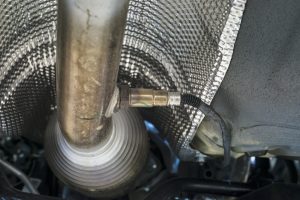What the heck is an Oxygen Sensor?
What the heck is an Oxygen Sensor?
What does it mean when the check engine light comes on in your car, truck, minivan, or SUV? One of the most common causes of the check or service engine light and a corresponding heater circuit malfunction code is a faulty or failing O2 sensor.

History of Oxygen Sensors
- The O2 sensor was developed in the late 1960s by Dr. Gunter Bauman at the Robert Bosch GmbH Company, a global manufacturer of auto parts and components.
- The first O2 sensor was installed in the Volvo 240 in 1976.
- In 1980, the state of California, in the United States, began passing laws that required O2 sensors on vehicles.
- Federal regulation followed in 1981 requiring O2 sensors or vehicles and light trucks.
- With ODB-II regulations, vehicles with model years 1996 and later have one to four O2 sensors installed.
What is an oxygen sensor?
An O2 sensor is an electronic device that you’ll find located in your vehicle’s exhaust manifold.
What does the O2 sensor do in a vehicle?
The O2 sensor helps to measure the air-fuel mixture in your vehicle. It works by measuring the amount of oxygen in your exhaust and sends the information to the computer control unit or ECM.
Why do I need to monitor my vehicle’s oxygen level?
Monitoring O2 levels is important because too much oxygen in the exhaust can lead to poor performance and cause engine problems. While not enough oxygen can cause excessive emissions, reduced fuel economy, and lead to catalytic converter damage. In states and provinces that monitor emissions and require vehicle testing, a check engine light due to a faulty O2 sensor can cause your vehicle not to pass emissions testing and may require you to invest in costly repairs prior to re-testing.
Where are the O2 sensors located in my vehicle?
Most vehicles have one O2 sensor located in front of or near the catalytic converter and in the exhaust manifold. Many later model vehicles like the Chevrolet Tahoe, Honda Civic, Jeep Wrangler, and Toyota Land Cruiser have four sensors. Your vehicle’s engine type also determines the number and location of your O2 sensors.
- Traditional V6 and V8 engines have left and right bank upstream and downstream O2 sensors
- Transverse V6 and V8s have left front, right rear, downstream, and rear engine sensors.
- In-line 4 and in-line 6 engines have front and rear bank upstream sensors and a downstream sensor.
- Transverse 4-cylinders engines have an upstream and downstream sensor.
How often should I replace the sensor in my vehicle?
Consult your owner’s manual for suggested O2 sensor service and replacement intervals. Many vehicles have a 50,000-kilometer O2 sensor life, while some vehicle makes, and models last up to 100,000 kilometers. Given the location of the O2 sensor, it is constantly exposed to extreme temperatures; carbon, soot, and other debris; and gases and chemicals that cause wear and reduce the efficiency of the sensor.
Symptoms of Failing O2 Sensor
Even if your check engine light never comes on, your car may be giving your signals that your O2 sensors are failing or going bad.
- A sudden and rapid decrease in fuel economy can occur long before the engine light comes on. When the air to fuel mixture is not optimal, your car uses fuel inefficiently and burns more gasoline at the faster rate.
- Too little oxygen leads to excessive emissions coming from your car’s exhaust. It’s important to make sure your vehicle is moving carbon monoxide away from the vehicle and not backing up into the passenger cabin. At the same time, you’ll want to minimize emissions going into the atmosphere, especially in areas with emissions laws and regulations.
- Poor performance including rough idling, stalling, hesitation, and poor acceleration.
Testing Your O2 Sensors
With the right auto parts and equipment, you can check and replace the O2 sensors in your vehicle.
If your check engine light is on, use an ODB-II code reader to find the related engine diagnostic codes. You’ll also need the tool to reset the engine light after your repairs are complete. To test the sensor, you’ll need a 10-megaohm impedance digital voltmeter. Next, you’ll need to locate the sensors in the vehicle.
- Warm the vehicle up to normal operating temperature. Run or drive it for 15 to 20 minutes.
- Set the voltmeter to millivolt DC scale.
- Use a jack to lift and support the vehicle if you are checking the sensor near the catalytic converter.
- Check the wiring diagram in your vehicle manual for the proper sensor to meter wire connections.
- Check for a normal operating range of 0.10 to 0.90 V.
- If your results are outside of the normal range, you can run additional tests or proceed to replace the O2 sensors.
Replacing Your Vehicle’s O2 Sensors
Make sure you have the right tools and car parts including:
- Replacement O2 sensors
- O2 sensor socket
- Basic hand tools
- Jack and jack stand
- Once you’ve located the faulty sensor, disconnect the wiring harness connector and remove the O2 sensor with a socket or wrench.
- Next, compare the new sensor to the existing one to ensure proper fitting.
- Now, you can install the new sensor and reconnect the harness and wiring.</li
- Use the ODB-II tool to clear any engine codes and ensure that your check engine light is off.
- Finally, start the vehicle and make sure the engine light is off. Test drive to make sure that fuel economy and normal performance has been restored.
- You’re ready also to repeat vehicle emissions testing.
Now that you understand the basic function of vehicle oxygen sensors, you can choose the right car parts and accessories and do the required maintenance to keep your vehicle operating at peak performance.
